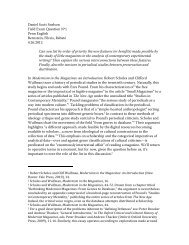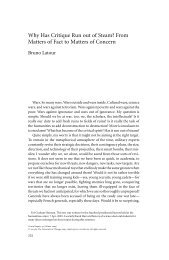The Exploit: A Theory of Networks - asounder
The Exploit: A Theory of Networks - asounder
The Exploit: A Theory of Networks - asounder
You also want an ePaper? Increase the reach of your titles
YUMPU automatically turns print PDFs into web optimized ePapers that Google loves.
84 Nodes<br />
U.S. Navy computer clusters). Over the years, a whole bestiary <strong>of</strong><br />
infectious code has come to populate the information landscape,<br />
including spam, spyware, and adware, as well as other nonvirus automated<br />
code such as intelligent agents, bots, and webcrawlers.<br />
Computer viruses thrive in environments that have low levels <strong>of</strong> diversity.<br />
Wherever a technology has a monopoly, you will find viruses. <strong>The</strong>y<br />
take advantage <strong>of</strong> technical standardization to propagate through the<br />
network. (This is why Micros<strong>of</strong>t products are disproportionately infected<br />
by viruses: Micros<strong>of</strong>t eclipses the marketplace and restructures<br />
it under a single standard.) Viruses and worms exploit holes and in<br />
this sense are a good index for oppositional network practices. <strong>The</strong>y<br />
propagate through weaknesses in the logical structure <strong>of</strong> computer<br />
code. When an exploit is discovered, the broad homogeneity <strong>of</strong> computer<br />
networks allows the virus to resonate far and wide with relative<br />
ease. <strong>Networks</strong> are, in this sense, a type <strong>of</strong> massive amplifier for action.<br />
Something small can turn into something big very easily.<br />
Anyone who owns a computer or regularly checks e - mail knows that<br />
the virus versus antivirus situation changes on a daily basis; it is a game <strong>of</strong><br />
cloak - and - dagger. New viruses are constantly being written and released,<br />
and new patches and fixes are constantly being uploaded to Web sites.<br />
Users must undertake various prophylactic measures (“don’t open<br />
attachments from unknown senders”). Computer security experts<br />
estimate that there are some eighty thousand viruses currently recorded,<br />
with approximately two hundred or so in operation at any given<br />
moment. 63 Such a condition <strong>of</strong> rapid change makes identifying and<br />
classifying viruses an almost insurmountable task. Much <strong>of</strong> this changeability<br />
has come from developments in the types <strong>of</strong> viruses, as well.<br />
Textbooks on computer viruses <strong>of</strong>ten describe several “generations”<br />
<strong>of</strong> malicious code. First - generation viruses spread from machine to<br />
machine by an external disk; they are <strong>of</strong>ten “add - on” viruses, which<br />
rewrite program code, or “boot sector” viruses, which install themselves<br />
on the computer’s MBR (master boot record) so that, upon<br />
restart, the computer would launch from the virus’s code and not the









